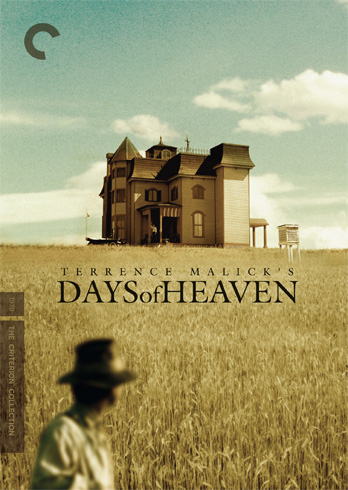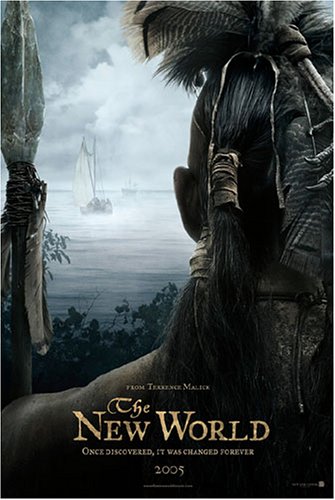by Jason Bellamy and Ed Howard
The House Next Door (Slant Magazine)


Jason Bellamy: Terrence Malick's next film, due soon in theaters, is called The Tree of Life, and coincidentally or not it is set up by the final shot of Malick's previous film, The New World. In both the theatrical and extended cuts of that 2005 film, Malick closes with a shot at the base of a tree: gazing up the side of its mighty trunk as it stretches heavenward. It's a quintessentially Malickian shot, both in terms of the camera's intimacy to its subject and in the way that it presents nature with a spiritual awe, as if the tree's branches are the flying buttresses of a grand cathedral. But the reason I mention that shot is so I can begin this discussion by acknowledging its roots. We've been regular contributors to The House Next Door for almost two-and-a-half years now, and, as loyal House readers know, Terrence Malick's The New World is the seed from which this blog sprouted. What began in Janurary 2006 as Matt Zoller Seitz's attempt to find enough cyber real estate in which to freely explore his passion for The New World—a rather Malickian quest, if you think about it—became something much bigger, until now here we are: writing about the filmmaker without whom this blog and thus this series might not exist.
I make that acknowledgement en route to this one: By the very nature of its origins, The House Next Door has always been something of an unofficial Terrence Malick fan club—nay, house of worship. Many of us first gathered at this site because of this subject matter. (Any immediate kinship many of us felt with Matt was inspired by a shared religious experience with The New World, not to mention the holy awakening of seeing serious criticism posted to the Web by amateur means.) I make this observation in the interest of full disclosure—less an acknowledgement of the House's origins, which so many of its readers know already, than an indication of my awareness of it—in the hopes that by doing so I can convince the Malick nonbelievers that they are welcome here. Because, see, Malick is one of those filmmakers who seems to inspire two reactions: genuflecting reverence and head-scratching ennui. Is there room between the two? Or are total immersion and deference to Malick's filmmaking elemental to its effect? In Part I of this discussion, we will look at Malick's first four films, Badlands (1973), Days of Heaven (1978), The Thin Red Line (1998) and The New World (the theatrical cut), and what I hope we begin to uncover is why Malick's filmmaking inspires such divergent reactions.
I am, admittedly, a singer in Malick's choir. His films don't move me equally, but when they do move me I'm profoundly affected. You come into this conversation having just watched most of Malick's films for the first time. So let me ask a question that will cause the Malick agnostics to roll their eyes and the Malick believers to raise their hands to the sky like Pocahontas in The New World: Did Malick's filmmaking inspire you with a unique sense of awe, or do you feel like you're on the outside looking in, or something else?
Ed Howard: You're right, prior to this conversation I had only seen Days of Heaven, so I came to the rest of these films as an agnostic, aware of the two opposing and equally forceful reactions to Malick's work and ready to be either awed or let down. Instead, I find myself thinking that there is room between the two reactions, or rather that there's room to flow between them, to go from being awed one moment to bored the next, to vacillate between thinking that Malick's distinctive sensibility is either sublime or silly.
In that light, I think one major reason that Malick's films are so divisive is that they're so nakedly emotional, that he's so blatantly aiming for the sublime. To be clear, this isn't a criticism. I admire and love all of these films to one degree or another, even though I never quite reach the level of awed transcendence that so many seem to find in Malick's work. I'm saying that Malick aims high, that his films are often not grounded in storytelling or character—instead, his films drift almost irresistibly toward the clouds, toward the treetops, toward the allegorical implications of the basic scenarios he explores. Sometimes that drift sacrifices the human element in his films, so that the characters and their human-scale stories seem to fade into the beautiful landscapes, overlaid with larger allegories about human society and history as a whole.
All of which suggests a grand sense of ambition. Days of Heaven has a very familiar love triangle at its core, but it seldom feels like that story is the point so much as the larger thematic currents about Depression-era America and social hierarchies. The Thin Red Line is packed with individual characters, but the film is really not about any one man as much as it is about their common humanity in the face of mortality and the evils of war. The New World isn't just—or even primarily—a love story but an allegorical fable about the origins of America and a deeply spiritual examination of the dialectic of progress and stasis. The point is, Malick thinks big, juxtaposing the transience and smallness of individual human lives with history-spanning events like the growth of a tree, the slow and unstoppable churning of natural processes. Maybe that's why large, ancient trees are so important to Malick's most recent films: The Thin Red Line begins with a tree, The New World ends with one, and a tree will presumably be at the center of The Tree of Life. A large tree, growing slowly over decades or even centuries, its roots stretching out into the earth even as its branches spread through the sky, is a perfect metaphor for Malick's expansive perspective on life and death, those big-picture subjects that constitute the heart of his work.
JB: That's true. And of course on a very basic level Malick's tree shots evoke not just his themes but his tendencies. Malick's films are famous for—or, in some circles, notorious for—their frequent observations of environment, which in most cases means observations of the natural world. In determining why Malick's films prove divisive, it's safe to start there, because there aren't too many better ways for a director to be written off as pretentiously artsy than to point a camera at flora and fauna and observe them as something beyond mere scenery.
Malick regards nature with fascination and romanticism, replacing the metaphorical textual descriptions of poets with vivid celluloid images. He's unashamed about his reverence, capturing creatures and plant life with the kind of closeups usually reserved for the productions of National Geographic or the Discovery Channel. In Badlands, we are shown branches and leaves, a gasping catfish and a big black beetle. In Days of Heaven, we stare into the husks of the wheat harvest and the tiny jaws of the locusts that devour them. In The Thin Red Line we encounter crocodiles, birds, a snake and a butterfly, all amidst a forbidding jungle. In The New World, it's chickens, cattle, rivers, forests, storms and blue sky. I could go on. Malick presents such images with a deliberateness that makes many viewers uncomfortable, perhaps because nature is the stuff of poetry and poetry is the stuff of emotion and vulnerability. American audiences are accustomed to ogling cars, guns and cityscapes, but not nature. Nature in most American films is the stage on which the action happens. In Malick's films, nature is part of the action itself.
Of course, nature in Malick's films often feels like an observer of the action, too. That's what you were getting at in describing the way Malick juxtaposes "the transience and smallness of individual human lives" with "the slow and unstoppable churning of natural processes." In Malick's films, man chops down nature to make his home. He harvests it to make his fortune. He hides within it to protect his life. He reshapes it to please his own eye. But he never fully conquers it. Nature is too big and too powerful for that, and only nature seems to know it.
To Read the Rest of the Conversation


No comments:
Post a Comment